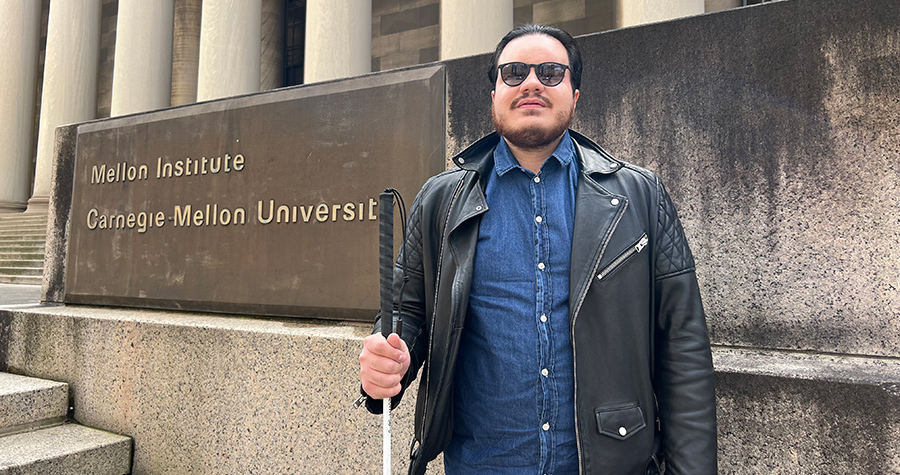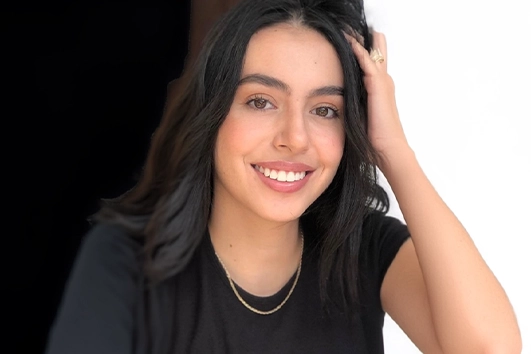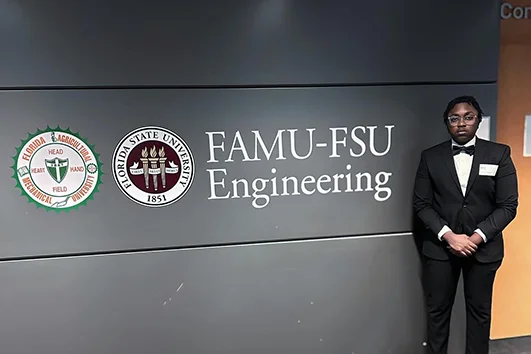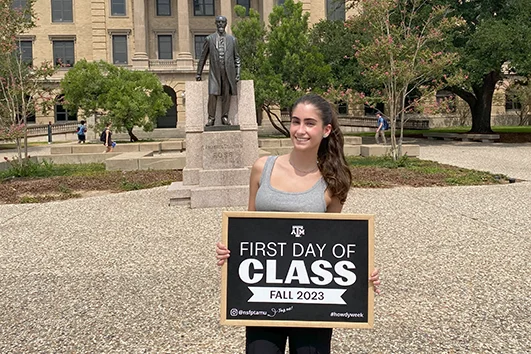Lucas Nadolskis
Lucas is currently in the first year of a PhD program at the University of California, Santa Barbara, in the Dynamical Neuroscience Department. His research is now housed within the innovative Bionic Vision Lab, under the adept guidance of Dr. Michael Beyeler. The team’s collective aim is to forge new paths towards smart bionic vision solutions for blind individuals, this effort builds on Lucas’ foundational work at the University of Minnesota, where he completed a BS in Computer Science with a minor in Neuroscience, and at Carnegie Mellon University, where Lucas earned an MS in Biomedical Engineering.
Lucas’ academic and research interests have broadened significantly, encompassing the development of novel devices for blind and low-vision users, enhancing accessibility within Human-Computer Interaction (HCI), delving into neuroscience, and exploring the potentials of brain-computer interfaces (BCIs). Additionally, understanding the neural mechanisms of blindness across various brain regions has become a pivotal aspect of his research work.
Deeply committed to improving the lives of blind and low-vision individuals worldwide, with a particular focus on underdeveloped countries, his dedication extends beyond the laboratory and academia; in alignment with this commitment, Lucas serves as a mentor for the NEVE Scholars Program, aiming to support undergraduate students through their crucial college years by providing essential resources and guidance for both their current and future research endeavors. When not engrossed in lab work or contributing from home, he finds solace and joy in cooking, traveling, and immersing himself in the world of audiobooks.
As a blind man, I always held immense gratitude for what life has gifted me, and what it has not. I have been fortunate enough to be surrounded by incredibly supportive people and amazing opportunities throughout my life. Being blind, as daunting as that felt at first, has motivated and guided me on a singular path in computer science. It instilled in me unique perspectives and skills to work on research projects in the field of artificial intelligence (AI) and human intelligence to help people in need. Most importantly, it fostered my passion for academic research.
From a young age I learned how difficult it would be for me to achieve my academic goals. When I became blind, my parents decided that I wouldn’t study in special schools, because they wanted to try to raise me as normally as possible. However, things didn’t go as smoothly as we had thought. I was rejected from many schools, and even when I was finally accepted by one, we were asked to provide the materials and the adaptations ourselves. My mother needed to learn braille, and we needed to constantly find resources to make the coursework accessible. This was the situation until high school. Seeing how hard it was for me to simply get an education, when the time came for me to decide on college, it became clear that my subject would be computer science. I thought that computers had reduced the gap between blind and sighted, and therefore, that these were the key to a more accessible world. Obtaining a degree in computer science would allow me to work with accessibility and with that I could develop new technologies to assist kids who are in the same condition that I was at the time.
When I first started my undergraduate studies at the University of Minnesota, it was difficult—not only because it is a completely different country, culture and climate, but also because I was behind in a lot of concepts due to my education in Brazil. Nevertheless, I managed to overcome those difficulties with the incredible support from the university, professors, TAs, and classmates. My experience at the University of Minnesota helped me consolidate my knowledge in computer science and foster my interests and passion in research. Specifically, at the cross-section of AI and human intelligence. Most importantly, it inspired me to become the person that I am today, and gave me the motivation to continue working on groundbreaking research to benefit people in need and make a positive impact in this world.
I first started considering doing a research project during the second year of undergraduate. After seeing how professors were using computer vision on projects involving accessibility for blind people, I immediately registered for a computer vision class, and received a “A-” after a semester of hard work. Dr. Hyun Soo Park, who taught that class, was working on a project at the time that uses computer vision to assist blind and low-vision people in navigational tasks. After the class was over, I joined his team for my first research project. While at his lab, I discovered that I was able to offer some unique perspectives as a blind person. One of the tasks of my research was to come up with questions that blind people would potentially ask during daily navigation. My knowledge of what it is like to navigate as a blind person gave me ideas of what kind of questions would be asked from the users’ point of view, and made me think about how to write the code to answer them. This opened my eyes to the fact that research could be a very rewarding path for both myself and the greater research community, given the unique experience and perspectives that I am able to offer.
From there, I have been involved in research ever since. Not long after my project with Dr. Park, I took my first neuroscience class. The subject captivated me greatly, and prompted me to minor in neuroscience. The computational analogies between biological circuits and their artificial counterparts were striking, and I started to feel the power of integrating AI and biological functions. During the fall of 2020 I began my research with Dr. Catherine Qi Zhao, working at the intersection of AI and human intelligence. In one of my research projects I developed new AI and deep learning methods to decode amputee's motor intention based on their peripheral nerve activities.
A critical challenge in this research was to detect and sort neural spikes from the noisy signals collected with multi-channel electrodes. Since most spike sorting algorithms developed on synthetic datasets do not work directly on clinical data, these were unable to correctly process our data. Specifically, signals from different neurons have different spike shapes, and my research goal was to cluster spikes and separate them from outliers. I started my research by analyzing the strengths and weaknesses of specific machine learning algorithms such as SOM, K-Means, LDA and GMM on the spike sorting task by testing them on a diversity of datasets. With this knowledge, I worked on developing a new spike sorting algorithm that handled the artifacts and noises. However, there were numerous difficulties along the way. For one, qualitative evaluation and visualization play a significant role in developing spike sorting methods, but unfortunately, I could only assess the performance of my method based on quantitative evaluation results that can be read by my screen reader. As a result, I instead explored multiple quantitative evaluation metrics to comprehensively evaluate different aspects of the methods. Issues like this always arise in my academic and research experience, but in most cases I was able to find creative solutions to work around them due to my technical and personal background.
In addition to being drawn into the field of AI and neuroscience applied to basic research, I am constantly motivated by all the possibilities that these technologies can provide to benefit my own day-to-day life. When I first moved to Minnesota, new challenges arrived. The main one probably being the snow. I had never seen snow before. During my first year, during one snowy day, I was going from my dorm to class when a bus suddenly stopped in front of me. The bus driver kindly informed me that I was walking on the train tracks, and that it would be a good idea to move to the sidewalk. Because I can’t feel the difference of the ground texture when it is covered in snow, a street or a sidewalk feel the same thing to me. Additionally, on snowy days it gets harder to hear the cars, and since I use the sound to measure distance to objects, walking becomes especially difficult on those days. At the end of that day, all of these minor inconveniences got me thinking—what if we apply AI and machine learning methods to overcome retina disabilities by sending images straight to the visual cortex, just like what we did to help the amputee patients at Dr. Zhao’s lab? What if the same could be done with us who have lost our retina? Such techniques and systems could potentially benefit many people with disabilities and greatly improve their quality of living.
That urge to assist people in similar conditions as me, together with my passion for research, led me to apply for the master in Biomedical Engineering at Carnegie Mellon University, where I started my program in the fall of 2021. That was an incredible opportunity for me. I was to be the first blind student, once again, but this time in a top-notch university with endless potential for research and networking. However, as it is common for me, being the first has its challenges.
As the first blind student in the BME department and one of the few ever at CMU, I had to overcome multiple challenging situations. Having to convert myself many documents between word and braille was one of them. In the class, I needed to work with professors to adapt the materials that were written for sighted students, since visual examples were being used for both class and assignments. The professors and the university were incredible at giving me all of the necessary support, but nevertheless it required a lot of effort on my part. However, I am more than accustomed with this position, and I have learned how to gather strength from difficult situations and catalyse this into creative solutions.
In October of 2021, I started working with Professor Matthew Smith, who runs a computational neuroscience lab largely focused on understanding vision. For my master’s thesis, I have begun to work on a very challenging problem, which, however, directly touches on my dream research project: that of encoding sensory information directly into the visual cortex. In particular, my work is centered on understanding the effect that artificial inputs delivered into the visual areas of monkeys have on their neural activity. With this understanding, we aim to design stimulation patterns that can drive the visual neurons in a desired fashion, allowing us to trigger different visual percepts in monkeys. As one can imagine, this is one of the most exciting times for me in my young research career. The project I am currently working on will provide me with invaluable knowledge and expertise, which will be crucial to pursue the career path I intend to focus on in the future.



